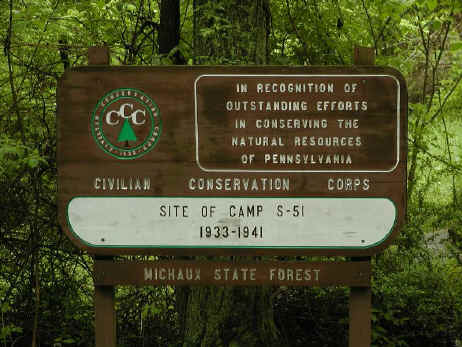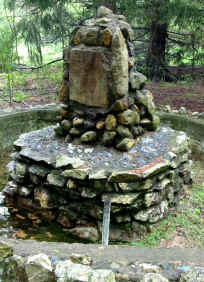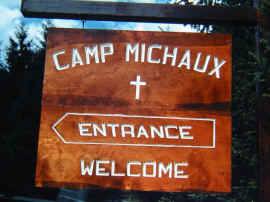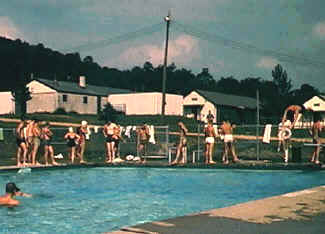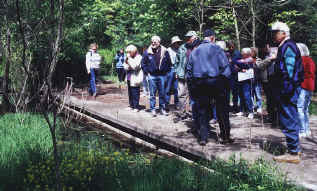|
THE HISTORY OF CAMP
MICHAUX
David L. Smith -- Cumberland
County Historical Society -- July 2010
The map and key to the buildings
Nestled in the ridges of
South Mountain, two miles northwest of Pine Grove Furnace along Michaux
Road, lies the site of Camp Michaux. This church camp, formerly
shared by the United Presbyterian Church and The United Church of
Christ, has an unusual history that is linked to the iron industry in
the late 18th, 19th and early 20th centuries. The history
continues with a Civilian Conservation Corps Camp during the Great
Depression and a secret Prisoner of War Interrogation Camp during World
War II before the advent of the church camp.
The history of the site
begins in 1785 with the establishment of a farm that came to be known as
Bunker Hill Farm. The farm consisted of approximately 250 acres
and was acquired early in its history by the growing iron industrial
complex at Pine Grove Furnace and Laurel Forge. It was one of
several farms owned by the iron industry and was used to supply food for
men and their families who worked for the company as well as food for
animals that were part of the mining operation. The extensive farm
operation led the owners of the South Mountain Mining Company to hire a
farm expert in 1878 to assist with management of the farms. J.D.
North was an expert planter and fruit culturist from North
Carolina. Later in 1887, three of the farms including Bunker Hill
Farm were leased to William F. Swigert. The iron industry failed
in the late 19th century but for a time a brick works at Pine Grove kept
the company town alive until 1912 when the State of Pennsylvania
acquired the entire iron industry estate’s sixty square miles for
$29,827.00.
The last lease holder of
the farm was John Gardner who leased it from the State. Because of
this some locals refer to the farm as the Gardner Farm. The only
surviving features of the farm are the large stone barn wall and the
foundations of the farm house nearby. Gardner gave up his lease in
1919 even though a year before it was reported that 1,000 bushels of
wheat had been produced there.
The land remained idle for
the next 13 years. In 1933, with the Great Depression gripping the
country, Franklin Roosevelt created the Civilian Conservation Corps
(CCC) as part of his New Deal. The Corp’s purpose was to provide
employment and training for young men ages 18 – 25. Sites across
the country were selected for this program and it was not uncommon for
former iron plantations to be selected because the iron industry had not
been environmentally kind to the land that it occupied and the land was
in need of reclamation. The former Bunker Hill farm was one of two
sites selected for the first two CCC camps in Pennsylvania.
The first CCC men arrived
to construct the camp on the old farm in early 1933. They arrived
from Philadelphia using the railroad that still operated between Hunter’s
Run and Pine Grove. The men stayed adjacent to the railroad
station and set up their dining tent in front of the furnace
stack. They walked the four miles round trip each day to the farm
site to begin construction of the camp. Once they had a dining
hall constructed, a tent camp was set up at the farm and from that time
on the CCC camp operated at the new site. By late December of
1933, the 200 men and their leaders could move into barracks that had
been constructed. During the course of the nine years Pine Grove
Furnace Civilian Conservation Corp S-51-PA was open, the men built
roads (including Michaux Road, the road that leads to the camp today)
installed telephone lines, reforested land throughout the region, built
infrastructure in the state park, and continually made improvements to
the CCC camp. By the time the camp closed there were more than 40
buildings at the site. With the advent of World War II in late
1941, the men were now needed for national defense and the CCC program
came to an end.
In 1942, the War
Department was faced with the need to house prisoners of war.
There was also need to learn strategic information from the prisoners
regarding weaponry, and the operation of the Nazi war machine.
Similar needs would emerge regarding the Japanese as the war
progressed. Interrogation sites were set up at Ft. Hunt, Virginia
and Byron Hot Springs, California in addition to internment facilities
across the country to house the prisoners for the duration of the
war. It was evident early on that Ft. Hunt could not handle the
interrogation demands and a second site was selected from among three
that were considered. That site was the former CCC camp at Pine
Grove Furnace.
The Pine Grove Furnace CCC
Camp was remodeled and two prison compounds erected, one for officers
and one for the other prisoners. Prison Compound One was the
larger of the compounds and was located near the CCC Fountain.
Compound Two was located by the old barn wall. Compound One had
four guard towers (the bases of two of them survive today), and Compound
Two had two guard towers (both bases can be seen today.) Prisoners
were interrogated in the former renovated Forestry Office building
located along Michaux Road (at that time called High Mountain Road) near
the former entrance to the CCC camp. Fencing around the entire
100+ acre site plus guard gates on High Mountain road prevented local
people from gaining access to the camp. There were more than 3,000
prisoners interrogated there during the course of the war including
Japanese prisoners toward the end of the war. A separate area for
the Japanese was created by erecting a fence in the middle of Compound
One.
The Pine Grove Furnace
Prisoner of War Interrogation Camp operated until the November of
1945. The land reverted back to the State at that time. The
land on which it was located was part of Michaux State Forest.
Andre Michaux was a French naturalist sent to North American by Louis
XIV. He was commissioned to study the plant life of the
Appalachian region and gather plants for the Royal Gardens.
Pennsylvania chose to recognize his contributions to the understanding
of the plants of the region by naming the forest for him.
In 1947 representatives of
the United Presbyterian Church and the United Church of Christ formed an
alliance and arranged with the State to use the former POW camp.
In 1948 a formal lease arrangement was worked out. Camp Michaux
Incorporated (this is the first time the name Michaux is given to the
property) ran summer church camps here until 1972 in addition to other
activities throughout the year. The Appalachian Trail held its
annual fall meeting at the site for 16 years. The churches were
responsible for maintaining the buildings and grounds. Leases ran
for 10 years with a $600.00 annual payment. The lease was renewed
in 1958 and again in 1968. In 1969 one of the few winterized
buildings on the site burned due to a malfunctioning furnace. That
building, called Michaux Lodge, had been the CCC Forestry Office and the
POW Interrogation Building. The churches did not want to replace
the building since they did not own the property. The State was
not interested in replacing it either. Without the revenue that
could be accrued from the use of the camp year round the churches
finally decided to abandon the lease in 1972. The camp closed at
that time.
The State was unable to
find other uses for the site and the buildings rapidly
deteriorated. In 1975, an auction of the buildings was held.
Purchasers of the buildings removed what ever they could take
away. What remained of the camp was removed. Today
foundations of several of the buildings remain as well as the CCC
fountain, the dams on Tom’s Run and the deck and control room for the
swimming pool that had been built by the churches.
Extensive research has
been done about the history of the site and can be found in a book
published by the Cumberland County Historical Society (CCHS) entitled Secret
War at Home, The Pine Grove Furnace Prisoner of War
Interrogation Camp by John Paul Bland. The book is available for
sale at CCHS and at Pine Grove Furnace State Park. Information can
also be learned by going to the following web site posted by a former
church camp at: www.scheaffersite.com/michaux.
Guided tours of the site
sponsored by CCHS are given by David Smith and John Bland each spring
and fall Contact the Society for information
about registering for the tours.
Army Map and
Key to the Buildings
|
